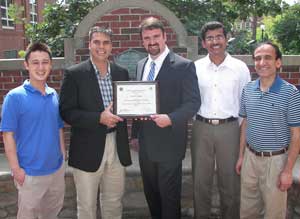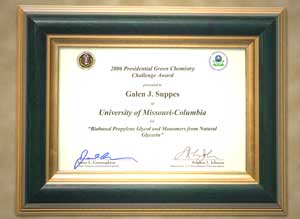The Preventative Chemist




January 24, 2007
BY Nicholas Zeman
The industrial revolution is not even two centuries old but the effects of combustion engines, wastes from agricultural production, and the manufacturing of dangerous chemicals and substances have damaged the Earth and its atmosphere. Compelling scientists to assume responsibility for pollution prevention and providing incentives to develop clean and efficient processing and manufacturing solutions for industry is the target of the Presidential Green Chemistry Challenge administered by the U.S. EPA. The competition addresses the technological and environmental issues of design, synthesis, production and use of products in continuous and discrete manufacturing industries, the EPA says.
Through environmentally conscious product and process design, "green chemistry" is an effective approach to preventing pollution by applying scientific solutions to concrete environmental concerns. Out of thousands of projects, and dozens of nominations made each year for the prize, only one award is given to an academic investigator. The 2006 winner was Galen Suppes, a professor of chemical engineering at the University of Missouri-Columbia (UMC), for his work refining glycerin, a by-product of biodiesel transesterification, into propylene glycol. The prestigious award is endorsed by the president of the United States and serves as an excellent validation for the technology Suppes is currently commercializing.
Suppes received a Ph.D. from Johns Hopkins University in 1989 and a bachelor of science degree from Kansas State University in 1985. Biodiesel developments and innovations were a particular research interest for him, especially the work performed at the Biomaterials and Bioprocessing Center, a laboratory at UMC that emphasizes the use of soybean and corn products in a variety of chemicals and materials.
Propylene glycol is currently used as a material in the production of aircraft de-icing solvents, cosmetics and personal care items. The big break for propylene glycol and glycerin could be the market for automotive antifreeze, which is approximately 3 billion pounds worldwide. In the same way that methyl tertiary butyl ether (MTBE) was phased out of the gasoline pool, the toxic ethylene glycol, the current staple of auto-coolant manufacturing, could be prohibited as an ingredient in antifreeze through legislation. "It could and should happen," Suppes says. If the hazardous ethylene glycol could be legislatively phased out as an ingredient for auto coolant, and if propylene glycol could fill the gap, it would certainly change the dynamics of the biodiesel business in a major way.
There are also health advantages to replacing ethylene glycol in automotive antifreeze. Ethlyene glycol in its pure form is an odorless, colorless, syrupy liquid. Despite its sweet taste, ethlylene glycol is toxic, and accidental ingestion can be fatal. Replacing hazardous materials with nontoxic alternatives is a mission of the EPA's challenge program, which requires that a candidate project incorporate 12 principles of green chemistry into its system. The principles include designing chemical products with little or no toxicity, running chemical reactions at ambient temperature and pressure whenever possible, and reducing the potential for chemical accidents-fires, explosions and releases into the environment. "There are chemical production plants that view radiator fluid as a hazardous material on-site," Suppes says. "Any spill or leak would have to be reported to the EPA."
Green chemists are also required to use catalysts instead of relying on stoichiometric reactions, prevent waste and design processes that use renewable raw materials. Of course, Suppes had to consider these parameters to win the prestigious EPA award. Propylene glycols derived from either petroleum, vegetable or animal feedstocks have the same chemical compositions, but the chemical reactions used in the conversion processes vary, Suppes says.
To chemically convert glycerin to propylene glycol, the reaction requires adding a diatomic hydrogen molecule to, and removing a water molecule from, the glycerin. Initially, there are three alcohol groups on the glycerin, and a reaction takes place through the copper-chromite catalyst that converts it into a molecule with two alcohol groups, which is known as propylene glycol.
Suppes' design has a number of advantages over previous methods that perform the conversion. One is that it requires less heat and less pressure in the reaction-428 degrees Fahrenheit versus 500 degrees Fahrenheit, and 145 pounds per square inch versus 2,170 pounds per square inch. The decreased requirements for heat and pressure translate into reduced costs.
Enlightened Use
The market demand for glycerin in the United States is about 600 million pounds, but biodiesel plants are expected to produce 1 billion pounds of the syrupy substance over the next two years. According to Suppes, bioidesel plants produce about one pound of glycerin for every nine pounds of fuel they make. Glycerin supply has been a major concern for producers, as detailed in Biodiesel Magazine's September cover story, "The Glycerin Glut." However, biodiesel may have found a steady and long-term outlet for its glycerin in the propylene glycol sector. Suppes says he has licensed the technology for the glycerin-to-propylene-glycol conversion to Senergy Chemical, Ltd. The first commercial facility to use his technology will have a capacity of 50 million pounds per year and is expected to be producing by January, Suppes says. However, he declined to reveal any details about the plant other than the fact it was being built by Senergy Chemical Holdings LLC. Senergy, based in Gig Harbor, Wash., describes itself as "a consortium of propylene glycol consumers and marketers with the common interest of developing novel, efficient and renewable sources of material," on its Web site.
The dependence on volatile petroleum crude oil as a source of propylene and propylene glycol has caused excessive price and supply instability. The development of Suppes' technology will help to eliminate this instability and give the marketplace supply options that it currently doesn't have, according to Senergy. The chemical company "intends to grow into a global supplier of propylene glycol and related materials" through the application of the "green" refining of glycerin into propylene glycol.
To further develop the catalytic technology that performs the conversion of glycerin to propylene glycol and to begin commercializing the product, Suppes formed Renewable Alternatives LLC in the summer of 2003. As stated on the company's Web site, part of its mission is to use chemistry, engineering, and renewable alternatives to provide applications that can benefit society and environmental quality. In other words the company aims to develop and commercialize products that can replace petroleum-based feedstocks.
Suppes says the propylene glycol application for glycerin could add about 40 cents a gallon to the profitability of various biodiesel producers and could be an integral component of future business plans, even though it will require a considerable amount of additional capital.
Suppes says this year could be a busy one with the construction of propylene glycol refineries, many of which could be collocated on biodiesel plant sites. Glycerin refineries should be designed to have good rail and barge access. "Propylene glycol refineries would want to have the ability to collect glycerol from multiple sources and to have contracts in place with several biodiesel plants," Suppes says. "Hydrogen is needed for the reaction, and that has an impact on logistics as well."
Large ag companies are moving toward propylene glycol production. In November 2005, ADM announced plans to build a polyols facility that would produce propylene glycol. The company is currently in the process of building its first bioidesel plant, an 85 MMgy facility at Velva, N.D. Cargill has announced plans to make propylene glycol a major column in its biodiesel business blueprint. Biodiesel companies with strong propylene glycol plans built into their strategies could have a considerable advantage going forward.
Nicholas Zeman is a Biodiesel Magazine staff writer. Reach him at nzeman@bbibiofuels.com or (701) 746-8385.
Through environmentally conscious product and process design, "green chemistry" is an effective approach to preventing pollution by applying scientific solutions to concrete environmental concerns. Out of thousands of projects, and dozens of nominations made each year for the prize, only one award is given to an academic investigator. The 2006 winner was Galen Suppes, a professor of chemical engineering at the University of Missouri-Columbia (UMC), for his work refining glycerin, a by-product of biodiesel transesterification, into propylene glycol. The prestigious award is endorsed by the president of the United States and serves as an excellent validation for the technology Suppes is currently commercializing.
Suppes received a Ph.D. from Johns Hopkins University in 1989 and a bachelor of science degree from Kansas State University in 1985. Biodiesel developments and innovations were a particular research interest for him, especially the work performed at the Biomaterials and Bioprocessing Center, a laboratory at UMC that emphasizes the use of soybean and corn products in a variety of chemicals and materials.
Propylene glycol is currently used as a material in the production of aircraft de-icing solvents, cosmetics and personal care items. The big break for propylene glycol and glycerin could be the market for automotive antifreeze, which is approximately 3 billion pounds worldwide. In the same way that methyl tertiary butyl ether (MTBE) was phased out of the gasoline pool, the toxic ethylene glycol, the current staple of auto-coolant manufacturing, could be prohibited as an ingredient in antifreeze through legislation. "It could and should happen," Suppes says. If the hazardous ethylene glycol could be legislatively phased out as an ingredient for auto coolant, and if propylene glycol could fill the gap, it would certainly change the dynamics of the biodiesel business in a major way.
There are also health advantages to replacing ethylene glycol in automotive antifreeze. Ethlyene glycol in its pure form is an odorless, colorless, syrupy liquid. Despite its sweet taste, ethlylene glycol is toxic, and accidental ingestion can be fatal. Replacing hazardous materials with nontoxic alternatives is a mission of the EPA's challenge program, which requires that a candidate project incorporate 12 principles of green chemistry into its system. The principles include designing chemical products with little or no toxicity, running chemical reactions at ambient temperature and pressure whenever possible, and reducing the potential for chemical accidents-fires, explosions and releases into the environment. "There are chemical production plants that view radiator fluid as a hazardous material on-site," Suppes says. "Any spill or leak would have to be reported to the EPA."
Green chemists are also required to use catalysts instead of relying on stoichiometric reactions, prevent waste and design processes that use renewable raw materials. Of course, Suppes had to consider these parameters to win the prestigious EPA award. Propylene glycols derived from either petroleum, vegetable or animal feedstocks have the same chemical compositions, but the chemical reactions used in the conversion processes vary, Suppes says.
To chemically convert glycerin to propylene glycol, the reaction requires adding a diatomic hydrogen molecule to, and removing a water molecule from, the glycerin. Initially, there are three alcohol groups on the glycerin, and a reaction takes place through the copper-chromite catalyst that converts it into a molecule with two alcohol groups, which is known as propylene glycol.
Suppes' design has a number of advantages over previous methods that perform the conversion. One is that it requires less heat and less pressure in the reaction-428 degrees Fahrenheit versus 500 degrees Fahrenheit, and 145 pounds per square inch versus 2,170 pounds per square inch. The decreased requirements for heat and pressure translate into reduced costs.
Enlightened Use
The market demand for glycerin in the United States is about 600 million pounds, but biodiesel plants are expected to produce 1 billion pounds of the syrupy substance over the next two years. According to Suppes, bioidesel plants produce about one pound of glycerin for every nine pounds of fuel they make. Glycerin supply has been a major concern for producers, as detailed in Biodiesel Magazine's September cover story, "The Glycerin Glut." However, biodiesel may have found a steady and long-term outlet for its glycerin in the propylene glycol sector. Suppes says he has licensed the technology for the glycerin-to-propylene-glycol conversion to Senergy Chemical, Ltd. The first commercial facility to use his technology will have a capacity of 50 million pounds per year and is expected to be producing by January, Suppes says. However, he declined to reveal any details about the plant other than the fact it was being built by Senergy Chemical Holdings LLC. Senergy, based in Gig Harbor, Wash., describes itself as "a consortium of propylene glycol consumers and marketers with the common interest of developing novel, efficient and renewable sources of material," on its Web site.
The dependence on volatile petroleum crude oil as a source of propylene and propylene glycol has caused excessive price and supply instability. The development of Suppes' technology will help to eliminate this instability and give the marketplace supply options that it currently doesn't have, according to Senergy. The chemical company "intends to grow into a global supplier of propylene glycol and related materials" through the application of the "green" refining of glycerin into propylene glycol.
To further develop the catalytic technology that performs the conversion of glycerin to propylene glycol and to begin commercializing the product, Suppes formed Renewable Alternatives LLC in the summer of 2003. As stated on the company's Web site, part of its mission is to use chemistry, engineering, and renewable alternatives to provide applications that can benefit society and environmental quality. In other words the company aims to develop and commercialize products that can replace petroleum-based feedstocks.
Suppes says the propylene glycol application for glycerin could add about 40 cents a gallon to the profitability of various biodiesel producers and could be an integral component of future business plans, even though it will require a considerable amount of additional capital.
Suppes says this year could be a busy one with the construction of propylene glycol refineries, many of which could be collocated on biodiesel plant sites. Glycerin refineries should be designed to have good rail and barge access. "Propylene glycol refineries would want to have the ability to collect glycerol from multiple sources and to have contracts in place with several biodiesel plants," Suppes says. "Hydrogen is needed for the reaction, and that has an impact on logistics as well."
Large ag companies are moving toward propylene glycol production. In November 2005, ADM announced plans to build a polyols facility that would produce propylene glycol. The company is currently in the process of building its first bioidesel plant, an 85 MMgy facility at Velva, N.D. Cargill has announced plans to make propylene glycol a major column in its biodiesel business blueprint. Biodiesel companies with strong propylene glycol plans built into their strategies could have a considerable advantage going forward.
Nicholas Zeman is a Biodiesel Magazine staff writer. Reach him at nzeman@bbibiofuels.com or (701) 746-8385.
Advertisement
Advertisement
Advertisement
Advertisement
Upcoming Events





